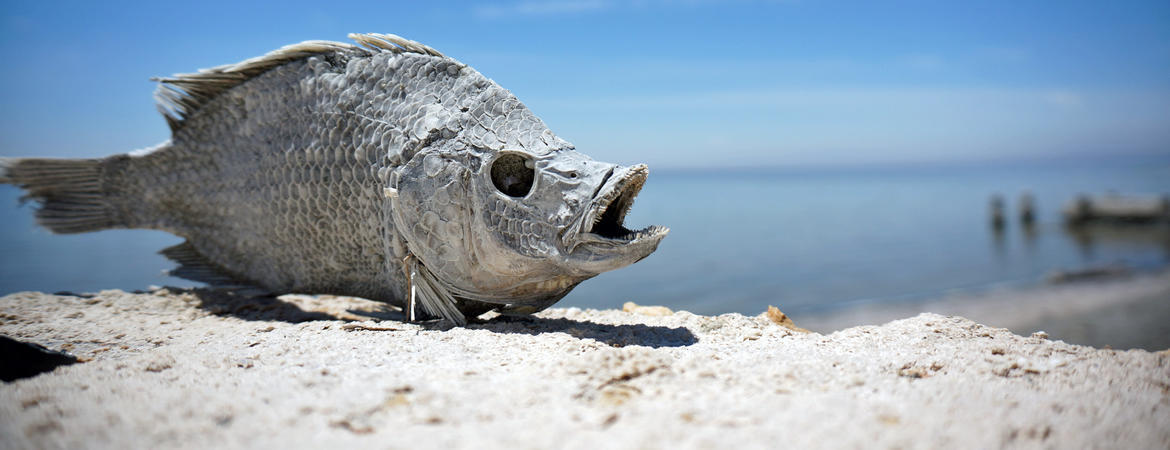
There are finally efforts under way to improve the environmental health disaster that is the Salton Sea — California’s largest and most polluted lake. However, a group of UC Riverside scientists, engineers, medical experts, and economists has published a new report warning that these efforts may not succeed.
The report warns that the scientific assumptions informing current mitigation efforts are outdated or lacking entirely. Due to rising salinity, accumulated chemicals, and a drying lake bed full of toxic dust, the worsening crisis threatens animals and humans alike. With the right interventions, the state could not only improve conditions but transform the sea into an economic powerhouse.
We asked members of UCR’s Salton Sea Task Force why now is the right time to expand research at the Salton Sea, what is causing some of the problems there, and what some of the solutions might look like.
Marilyn Fogel
Distinguished professor emerita of geo-ecology
“When you think about it, the major scientific studies were carried out decades ago when the sea had much lower salinity.”
— Fogel
Q: This summer, U.S. Rep. Raul Ruiz announced the Salton Sea Projects Improvements Act, which would authorize $250 million for restoration projects. Another $240 million for the sea is being negotiated between the governor’s office and the state legislature as part of a climate resiliency package. What should the legislature prioritize in their discussions about this spending?
A: We believe that a portion of the Salton Sea Improvements Act funding should be available to independent researchers to study — in real time — the efficacy of the restoration projects. For example, as dust mitigation measures are implemented in the southern part of the sea, we need to understand more about the characteristics of dust generated in this area and learn exactly what makes it toxic. Spending 5%-10% of a proposed $250 million budget on research as the work unfolds may prove to be an efficient use of funding and enable governments to shift their projects if unexpected results occur.
My colleagues and I have published a new report about the most critical areas for research at the Salton Sea. The final chapter discusses the opportunities for lithium extraction and geothermal power generation in the region, representing a possibility for improving economic growth.
Q: Why is now a good time for a report like the one you just released?
A: Shovels are literally going into the ground right now, starting restoration and air quality mitigation work. Our report emphasizes that now is the time to bring science onto the playing field and to create new ideas to help solve long-standing problems. “The Crisis at the Salton Sea” highlights areas of research that need to be addressed immediately as state and federal governments move forward. These areas include water policy, hydrology, water chemistry, air quality, ecology, and health problems emanating from the Salton Sea.
Q: There have been many articles written about the Salton Sea, yet not everyone is aware of the issues there. What do you think has been missing from discussions on this subject?
A: The idea that we know enough about the science of the region is shortsighted. When you think about it, the major scientific studies were carried out decades ago when the sea had much lower salinity. The ecosystem has evolved during this time to a state that is even more vulnerable. Bringing together an interdisciplinary team — including ecologists, biologists, botanists, air quality experts, and others — has the power to open up problem solving by recognizing that not just one magic bullet will fix the sea. Developing a dialogue between all stakeholders and scientists could provide new insights into the decades old problem of how to “fix” the Salton Sea.
Roya Bahreini
Professor of atmospheric science
“In terms of exposure, folks living in communities nearby are at the highest risk, but atmospheric pollutants can also get transported far downwind...”
— Bahreini
Q: Can you explain in layman’s terms how the Salton Sea drying up is polluting the air in nearby communities?
A: With the Salton Sea drying up, more of the dried lakebed (playa), which has accumulated salt, metals, pesticides, etc., gets exposed. Under windy conditions, these surfaces can give off particulate matter, transferring these materials into the air and exposing the communities downwind. Also, given the poor water quality of the sea itself, there could be material that comes off the sea water when waves break along the shores or during windy conditions.
Q: What are the best ways to improve air quality in the region?
A: The most ideal case to mitigate pollution coming off of the Salton Sea and its playa is if the area of the exposed lakebed is minimized and water quality is improved. The next best option is if lake bed areas that are most susceptible to wind erosion or areas that have the most toxic contaminants are kept under water.
Q: Could the problem of toxic air spread if nothing is done to improve the situation?
A: For sure — emissions of these different air pollutants are directly related to the extent of the playa being exposed and water quality. In terms of exposure, folks living in communities nearby are at the highest risk, but atmospheric pollutants can also get transported far downwind, so the effects may be felt even farther away.
Michael McKibben
Associate professor emeritus of geology
“Direct extraction from the sea’s geothermal brines can be very cost competitive and more environmentally friendly compared to more traditional lithium mining methods...”
— McKibben
Q: By some estimates, lithium production would need to increase 500% by 2050 to meet total demand for clean energy technologies, including electric vehicles, batteries for mobile devices, and energy-storage batteries. Can resources at the Salton Sea help with this demand?
A: Absolutely. Lithium production from the Salton Sea could easily meet the United States’ current demand for lithium, eliminate its reliance on imports, and help supply a significant fraction of current global needs as well. Direct extraction from the sea’s geothermal brines can be very cost competitive and more environmentally friendly compared to more traditional lithium mining methods from open pit mines or dry lake beds.
The latter methods generate mining waste, large evaporation ponds, noise and dust, and consume vast quantities of potable water and acidic reagents. In contrast, direct lithium extraction uses an already existing geothermal brine stream that is fully reinjected back into the ground. It involves considerably lesser amounts of water and chemicals.
Recent legislation mandates that all of the state’s electrical power come from renewable sources by 2045. Besides lithium, our new report discusses using electrolytic hydrogen and pumped water as methods for storing electrical power, which could help the state meet its goals.
Hydrogen gas produced by electrolysis of water, using electricity supplied by geothermal energy, can be stored or transported to provide electrical power. Pumped water can also be stored in raised reservoirs and released to generate hydroelectric power during peak demand hours.
We would also like to emphasize the employment opportunities and tax revenue that will be provided by expanded geothermal power production, the extraction of lithium, and the manufacture of lithium batteries for the local communities in the Imperial Valley.


